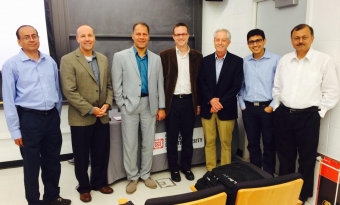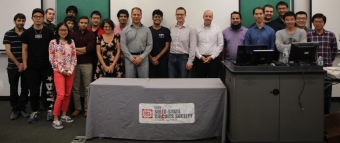 Imagine downloading a movie to your smartphone in less than a second. That’s the potential of the next generation (5G) of cellular network technology. Researchers say it will allow wireless transfer of data 10 times faster than the current 4G network. It will also have more capacity and better reach with multiple improved smaller antennas.
Imagine downloading a movie to your smartphone in less than a second. That’s the potential of the next generation (5G) of cellular network technology. Researchers say it will allow wireless transfer of data 10 times faster than the current 4G network. It will also have more capacity and better reach with multiple improved smaller antennas.
“The fifth generation (5G) cellular networks are coming,” explains Payam Heydari, a UC Irvine electrical engineering professor whose expertise is in the design and analysis of novel terahertz, millimeter-wave and radio-frequency integrated circuits, technologies that could revolutionize power-efficient wireless sensor networks.
As an IEEE Distinguished Lecturer for the Solid-State Circuits Society, Heydari spoke about the challenges and solutions of developing 5G technologies with engineering students and faculty at three East Coast universities: Lehigh, Princeton and Columbia.
“Millimeter-wave (mm-wave) and terahertz (THz) bands are underutilized regions of the electromagnetic spectrum that have generated a great deal of excitement for future systems that would be able to achieve very high speed wireless data transfer as well as wideband sensing/imaging applications,” Heydari explains. “The shorter wavelength associated with these bands is appealing since the physical dimensions of the antenna and associated electronics can be smaller, making it possible to design multiple antenna structures that can emit signals in various directions and even bounce off buildings.”
 On the lecture tour, Heydari presented an overview of recent advances in designing silicon-based integrated circuits. He discussed two case studies from UCI’s Nanoscale Communication Integrated Circuits Labs. One is the first 210-gigahertz wireless transceiver in complementary metal–oxide–semiconductor technologies that enables 20 gigabit-per-second wireless data transfer, and the second is the world’s highest frequency synthesizer at 300 gigahertz with a wide –tuning range, allowing very high resolution radar sensors for surveillance and security systems.
On the lecture tour, Heydari presented an overview of recent advances in designing silicon-based integrated circuits. He discussed two case studies from UCI’s Nanoscale Communication Integrated Circuits Labs. One is the first 210-gigahertz wireless transceiver in complementary metal–oxide–semiconductor technologies that enables 20 gigabit-per-second wireless data transfer, and the second is the world’s highest frequency synthesizer at 300 gigahertz with a wide –tuning range, allowing very high resolution radar sensors for surveillance and security systems.
This is a crucial time in the development of 5G. “We are talking about what technologies will define this next generation,” says Heydari. “Will 5G be just an evolution of 4G, or will emerging technologies cause a disruption requiring a wholesale rethinking of entrenched cellular principles?”
IEEE Distinguished Lecturers are engineering professionals who lead their fields in new technical developments that shape the global community. They serve two-year terms and deliver lectures at chapter meetings and regional seminars around the world.
